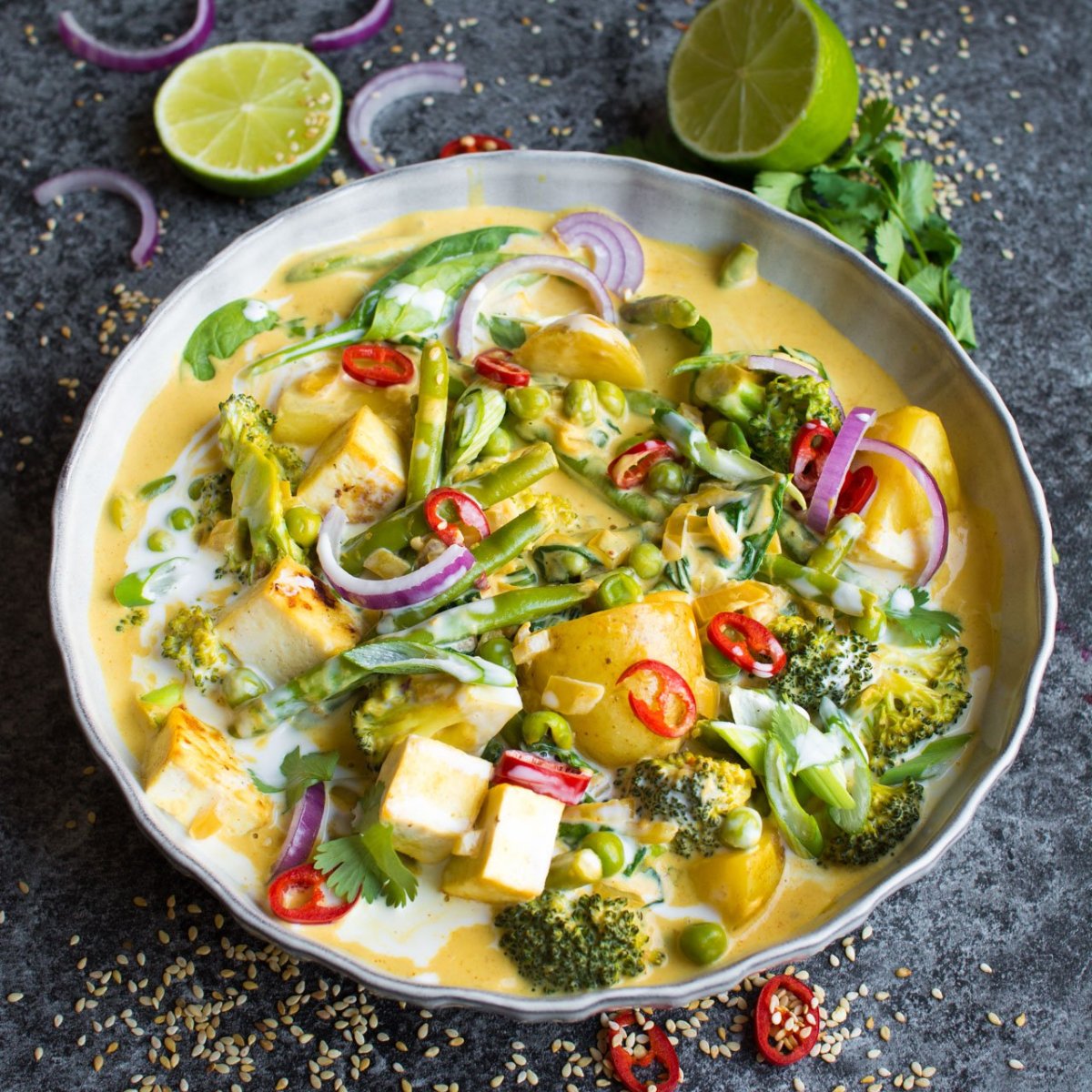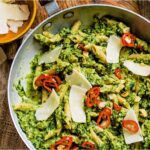Embark on a culinary adventure tonight with vibrant, flavorful, and adaptable Thai curries! This exploration delves into the exciting world of flexitarian Thai cuisine, showcasing three distinct curry variations brimming with aromatic spices and a delightful array of fresh ingredients. Prepare to be captivated by the rich tapestry of flavors, from the fiery heat of chilies to the subtle sweetness of coconut milk, all while enjoying the versatility of plant-based protein options. Whether you’re a seasoned cook or a culinary novice, these recipes are designed to be accessible and enjoyable, transforming your kitchen into a fragrant oasis of Thai delight.
We’ll guide you through detailed, step-by-step instructions for creating a luscious Panang curry featuring silken tofu, highlighting the visual transformation of the dish from raw ingredients to a steaming masterpiece. Discover the secrets to sourcing the finest ingredients for an authentic Thai experience, and learn how simple substitutions can subtly alter the flavor profile to suit your preferences. Finally, we’ll explore creative serving suggestions and accompaniments that elevate these curries from simple meals to unforgettable culinary experiences.
Popular Thai Curry Variations
Thai curries offer a vibrant spectrum of flavors, each a testament to the country’s rich culinary heritage. The foundation of most Thai curries lies in a paste of aromatics, chilies, and spices, which is then simmered with coconut milk, vegetables, and protein. The variations arise primarily from the specific blend of ingredients in the curry paste and the choice of accompanying elements. This exploration delves into three popular and adaptable flexitarian options, highlighting their unique characteristics.
Three Distinct Spicy Thai Flexitarian Curries
The following curries showcase the versatility of Thai cuisine, adapting easily to accommodate various dietary preferences while retaining their authentically fiery personalities. Each offers a distinct flavor profile, making them suitable for a range of palates.
| Curry Name | Key Ingredients | Spice Level | Flexitarian Protein Option |
|---|---|---|---|
| Massaman Curry | Peanut butter, cinnamon, cardamom, potatoes, onions, and beef or chickpeas | Mild to Medium | Chickpeas, firm tofu, or seitan |
| Panang Curry | Dried chilies, lemongrass, galangal, kaffir lime leaves, and coconut milk | Medium to Hot | Tofu, mushrooms, or lentils |
| Green Curry | Green chilies, cilantro, garlic, ginger, and green beans | Hot | Bamboo shoots, eggplant, or tempeh |
Flavor Profiles of Each Curry
Massaman curry, with its unique blend of sweet, savory, and subtly spicy notes from peanut butter, cinnamon, and cardamom, presents a rich and complex flavor profile. The creamy coconut milk base mellows the spices, creating a comforting yet exciting dish. The earthiness of the potatoes complements the other ingredients beautifully, creating a balanced and satisfying culinary experience. Imagine the velvety texture of the coconut milk clinging to tender chickpeas, their subtle nuttiness harmonizing with the aromatic spices.
Panang curry, in contrast, offers a more intense, yet balanced, experience. The vibrant red curry paste, packed with dried chilies, lemongrass, and galangal, delivers a fiery kick, tempered by the richness of the coconut milk. The kaffir lime leaves contribute a unique citrusy aroma that cuts through the richness, creating a refreshing counterpoint to the heat. The firm texture of tofu, absorbing the flavors of the sauce, provides a satisfying protein source that complements the curry’s intense flavor profile. Picture the vibrant red hue of the curry, punctuated by the glossy sheen of the coconut milk and the earthy tones of the tofu.
Green curry, the spiciest of the three, bursts with fresh, herbaceous flavors. The bright green curry paste, predominantly made with green chilies and cilantro, provides a sharp, intense heat that invigorates the palate. The addition of garlic and ginger lends a warm, pungent undertone that complements the vibrant green chilies. The tender texture of bamboo shoots, combined with the slight bitterness of eggplant, provides a textural contrast to the creamy coconut milk base. Envision the vibrant green color, a stark contrast to the deep red of the Panang curry, promising an exciting and invigorating culinary journey.
Serving Suggestions and Accompaniments

Elevating your Thai curry experience goes beyond the delicious sauce; thoughtful presentation and complementary side dishes significantly enhance the overall enjoyment. The vibrant colors and aromatic spices of Thai curries lend themselves beautifully to creative serving styles, transforming a simple meal into a feast for the senses. Careful consideration of accompaniments balances the richness of the curry, offering textural contrast and refreshing counterpoints to the intense flavors.
Serving suggestions should aim to showcase the curry’s beautiful colors and textures. A well-chosen presentation can transform a simple bowl of curry into a visually stunning dish. The accompaniments, carefully selected, provide a delightful interplay of flavors and textures, complementing and enhancing the curry’s already rich profile.
Creative Serving Suggestions
Three visually appealing serving suggestions for your spicy Thai flexitarian curry could include:
1. Individual Clay Pots: Serving the curry in individual, small clay pots adds a rustic charm and keeps the curry warm. Garnish each pot with a vibrant sprig of cilantro and a wedge of lime, creating a miniature culinary landscape. The earthy tones of the clay beautifully contrast with the rich colors of the curry, enhancing its visual appeal. Imagine the steam gently rising from the warm clay, adding an element of anticipation and visual intrigue.
2. Banana Leaf Presentation: For a more authentic and visually striking presentation, consider serving the curry on a large banana leaf. The natural green of the leaf provides a stunning backdrop for the vibrant colors of the curry, creating a tropical ambiance. Arrange the curry artfully on the leaf, perhaps with a small mound of jasmine rice beside it. The subtle aroma of the banana leaf subtly complements the fragrant curry, enhancing the overall sensory experience.
3. Modern Bowl Presentation: For a more contemporary approach, use a shallow, wide bowl to showcase the curry. Arrange the curry in the center, creating a visually appealing swirl or pattern. Garnish with toasted coconut flakes, chopped peanuts, and fresh herbs arranged artfully around the edge of the bowl, adding pops of color and texture. The clean lines of the bowl provide a modern contrast to the vibrant, rustic curry, creating a sophisticated and stylish presentation.
Suitable Side Dishes
A carefully chosen selection of accompaniments significantly enhances the Thai curry experience. These sides provide textural contrast and balance the intensity of the flavors, creating a more harmonious and satisfying culinary journey.
| Accompaniment | Description |
|---|---|
| Jasmine Rice | Fluffy, fragrant jasmine rice absorbs the delicious curry sauce, providing a soft, neutral base that contrasts beautifully with the spicy flavors. |
| Steamed Broccoli or Green Beans | The crisp-tender texture of steamed vegetables offers a refreshing counterpoint to the richness of the curry, adding a healthy and vibrant element to the meal. |
| Thai Salad with Lime Dressing | A light and refreshing Thai salad with a zesty lime dressing cuts through the richness of the curry, providing a cleansing palate cleanser between bites. The contrasting textures and flavors enhance the overall dining experience. |
| Crispy Fried Tofu or Tempeh | Adding a crispy element, such as fried tofu or tempeh, introduces a satisfying textural contrast to the creamy curry. The lightly browned exterior adds visual appeal and a savory counterpoint to the spice. |
| Mango Sticky Rice | For a truly decadent experience, serve a portion of mango sticky rice as a sweet and contrasting dessert. The sweetness of the mango and the chewy texture of the rice create a delightful end to the meal. |
The accompaniments enhance the overall dining experience by providing a balance of flavors and textures. The contrasting elements prevent the curry from becoming overwhelming, allowing diners to fully appreciate the nuances of the dish. The visual appeal of the accompaniments, when thoughtfully arranged, adds to the overall aesthetic pleasure of the meal, transforming a simple dish into a memorable culinary experience.
Spicy Thai Curry Cooking Techniques
Mastering the art of Thai curry involves understanding the interplay of heat, aromatics, and cooking techniques. The secret to a truly exceptional curry lies not only in the quality of ingredients but also in the precise order and timing of their introduction into the pot. By carefully controlling these factors, you can achieve a vibrant, aromatic, and perfectly balanced dish.
The foundation of any great Thai curry is the balance of flavors, with spiciness playing a starring role. Achieving the desired level of heat depends on careful selection and handling of chilies. The intensity of chili heat varies greatly depending on the type, so understanding this is crucial. For instance, bird’s eye chilies deliver a ferocious punch, while milder varieties like red chilies offer a gentler warmth. The secret to controlling spiciness lies in adjusting the quantity and type of chili used, as well as how they are prepared. Finely minced chilies release their heat more quickly and intensely than coarsely chopped ones.
Controlling Spiciness and Flavor Depth
The key to creating a perfectly balanced spicy Thai curry is to build layers of flavor gradually. Begin by gently toasting the spices – such as lemongrass, galangal, and kaffir lime leaves – in a little oil. This process unlocks their aromatic oils, creating a fragrant base for the curry. Next, add the chilies; if using fresh chilies, sauté them briefly to release their heat before introducing the aromatics like garlic, shallots, and ginger. This prevents the chilies from burning and ensures a balanced flavor profile. The paste, if using a pre-made one, should be added after the aromatics, allowing the flavors to meld together. Stir-frying the paste briefly before adding the coconut milk helps to prevent it from clumping. Adding the coconut milk gradually, stirring constantly, allows the flavors to integrate seamlessly, resulting in a rich, creamy texture.
Ingredient Order and Cooking Times
The order in which ingredients are added significantly impacts the final flavor. Aromatic ingredients like lemongrass, galangal, and kaffir lime leaves should be added first to allow their flavors to infuse the oil. Adding chilies before the aromatics can lead to a raw, bitter taste, while adding them too late can result in a less intense heat. Similarly, the coconut milk should be added towards the end of the cooking process to prevent it from curdling and to maintain its creamy texture. The timing of adding vegetables also matters. Heartier vegetables like potatoes or eggplant should be added earlier to allow them to soften, while delicate vegetables like spinach or beansprouts are best added towards the end. This prevents overcooking and preserves their vibrant color and texture.
Creating a Visually Appealing and Flavorful Dish
A visually stunning curry enhances the dining experience. Start by using vibrant, colorful ingredients. The contrasting colors of red chilies, green vegetables, and yellow coconut milk create an appealing visual effect. Consider the presentation as well. Garnishing the finished dish with fresh herbs like cilantro or basil adds a pop of color and enhances the aroma. A sprinkle of toasted sesame seeds or chopped peanuts provides textural contrast and visual interest. The final plating should be thoughtful, whether served in a shallow bowl to showcase the colorful ingredients or in individual ramekins for a more elegant presentation. The overall goal is to create a dish that is not only delicious but also a feast for the eyes.
Tonight, your kitchen becomes a gateway to the vibrant flavors of Thailand. From the initial sizzle of spices to the final, satisfying spoonful, the journey of creating these flexitarian Thai curries is as rewarding as the delicious results. Remember the importance of fresh ingredients and precise cooking techniques to unlock the full spectrum of flavors. Experiment with different protein options and accompaniments to personalize your culinary adventure. With a little creativity and these simple recipes, you can transport yourself and your guests to the heart of Thailand, one flavorful bite at a time. Enjoy the delicious journey!
Common Queries
Can I adjust the spice level?
Absolutely! Adjust the amount of chili peppers or chili paste to your preference. Start with less and add more gradually.
What if I don’t have all the ingredients?
Many ingredients can be substituted (see the ingredient substitution section). Don’t be afraid to experiment!
How long can I store leftovers?
Store leftovers in an airtight container in the refrigerator for up to 3 days.
Can I make this curry ahead of time?
Yes, the curry can be prepared a day in advance and reheated gently. The flavors will deepen overnight.
What are some good vegetarian protein alternatives to tofu?
Chickpeas, tempeh, and mushrooms work well as substitutes for tofu in these curries.


